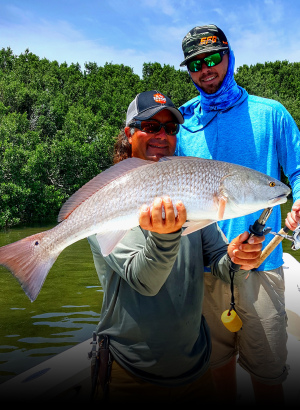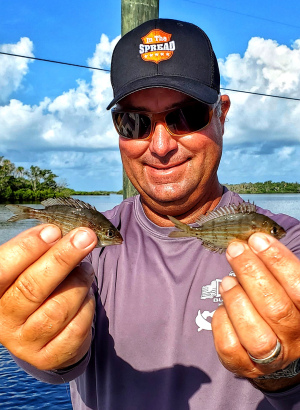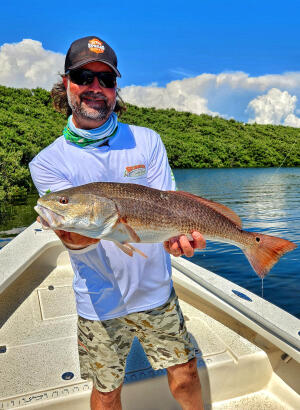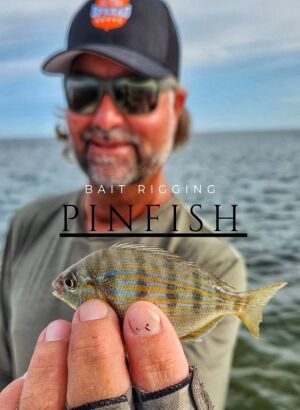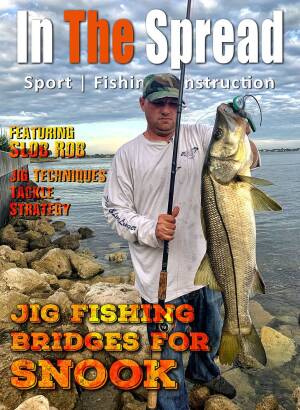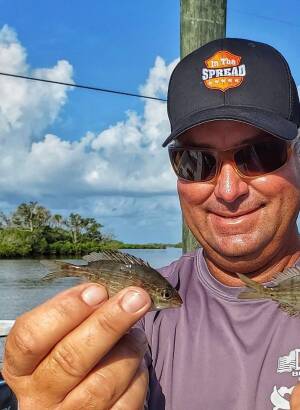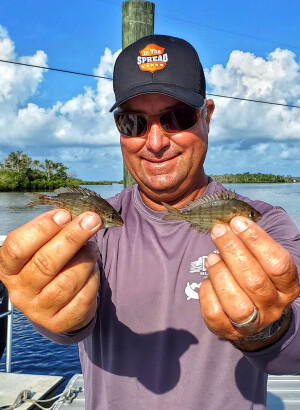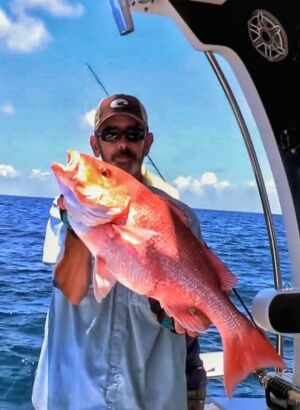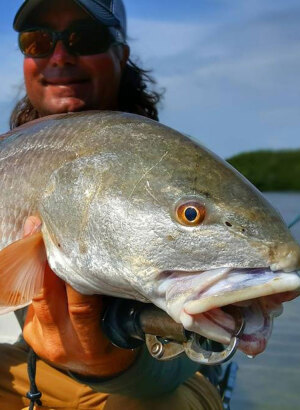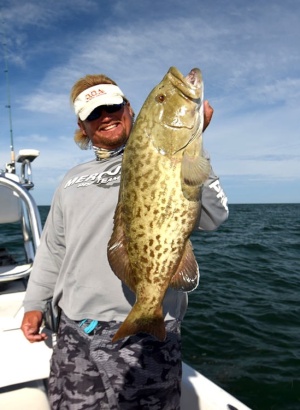Pinfish are a popular and effective baitfish for catching gamefish like redfish, snook, and seatrout. Rig and present them naturally to match conditions and target species. Handle with care to keep them lively for the best action. Learn more with this comprehensive guide.

Pinfish - A Comprehensive Guide
Pinfish, scientifically known as Lagodon rhomboides - a name derived from Greek meaning "raked tooth" and "diamond-shaped" - are a small, schooling fish from the family Sparidae, which includes species like porgies, sheepshead, and seabream. Commonly found in the coastal waters of the United States, these fish are known for their deep, compressed bodies, forked tails, and a singular dorsal fin with sharp spines, a feature that gives them their name due to their ability to erect these spines against predators and anglers, often causing painful punctures. Not only are pinfish a popular choice for recreational anglers who enjoy catching them on light tackle, often referred to as bream, butterfish, or sailor’s choice, but they are also highly valued as versatile baitfish for a variety of game fish. This article delves into the essentials of pinfish, from identification and habitat to diet and behavior, and provides insights on effectively using them as bait, along with tips and tricks to enhance your pinfish fishing experience.
Pinfish Identification
Physical characteristics of pinfish
- Body shape: Pinfish have a deep, compressed body that is oval or round in profile. They have a small mouth and a blunt snout.
- Spines: Sharp spines adorn their dorsal, anal, and pelvic fins, which they use for protection and defense. The spines can inflict painful wounds on predators and anglers alike, hence the name “pinfish”.
- Coloration: Characterized by a bright and colorful appearance, this paints, as such, helps them blend in with their surroundings and communicate with their mates. The black spot on the shoulder mimics the eye of a larger fish, which may deter potential predators. The dark bars on the sides create a disruptive pattern, which makes it harder for predators to single out an individual fish from the school.
- Fins: Their single dorsal fin has 12 to 14 spines and 10 to 13 soft rays. They also have a forked tail, a pair of pectoral fins, a pair of pelvic fins, and an anal fin with three spines and 11 to 13 soft rays.
- Teeth: Pinfish have strong and sharp teeth, which they use for biting and crushing their food. The teeth are arranged in rows, with the outer ones being larger and more visible. The teeth also help pinfish dig and scrape the bottom for food.
- Scales: Pinfish have small, cycloid scales that cover their body and head. They have a lateral line that runs from the gill cover to the base of the tail.
- Size: Even though they are known to grow up to 12 inches in length, most pinfish are between 3 and 5 inches. They can weigh up to 1 pound, but most are less than half a pound.
Distinguishing Pinfish From Other Similar Fish Species
- Pigfish: Pigfish (Orthopristis chrysoptera) are closely related to pinfish and have a similar body shape and color. However, pigfish have a more pointed snout and a larger mouth than pinfish. Pigfish also have a dark spot at the base of the pectoral fin, which pinfish lack. Pigfish have fewer spines on their dorsal fin (10 to 11) and fewer soft rays on their anal fin (9 to 10) than pinfish.
- Spot: Spot (Leiostomus xanthurus) are another fish species that resemble pinfish in shape and color. However, spot have a more elongated body and a smaller eye than pinfish. Spot also have a prominent black spot on their side, behind the gill cover, which pinfish lack. Spot have fewer spines on their dorsal fin (9 to 10) and fewer soft rays on their anal fin (8 to 9) than pinfish.
- Croaker: Croaker (Micropogonias undulatus) are a fish species that have a similar body shape and color to pinfish, but are usually larger and heavier. Croaker have a more rounded snout and a larger mouth than pinfish. Croaker also have a series of small bumps along the base of their dorsal and anal fins, which pinfish lack. Croaker have fewer spines on their dorsal fin (8 to 10) and fewer soft rays on their anal fin (7 to 8) than pinfish.
- Silver perch: Silver perch (Bairdiella chrysoura) are another fish species that resemble pinfish in size, shape, and color, but they have a more silvery body, and no black spot or dark bars. Silver perch also have a longer dorsal fin, and a more pointed head than pinfish
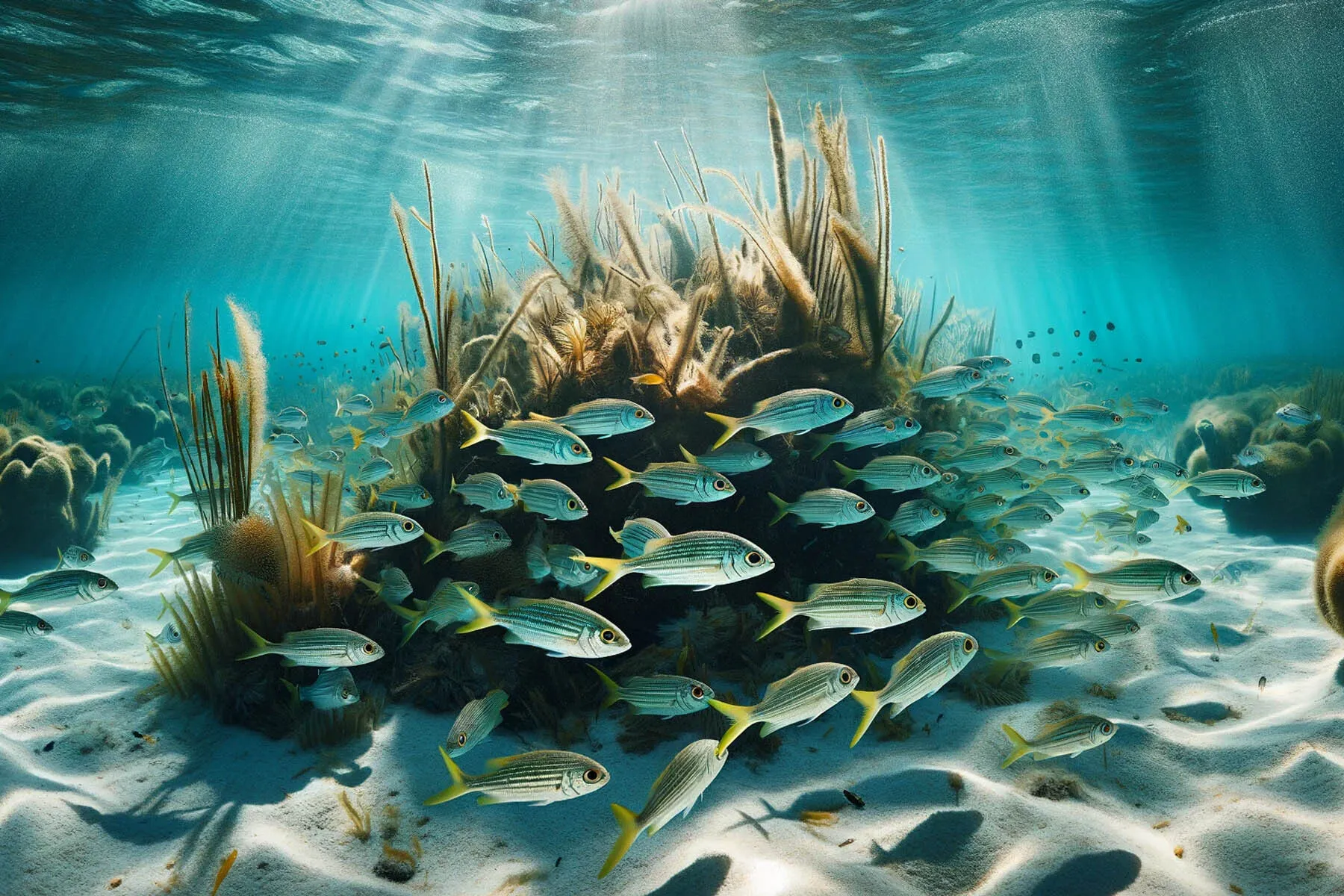

Pinfish Habitat
Diet of the Pinfish
Pinfish Behavior
Pinfish as Bait
Pinfish are one of the most common and versatile baitfish in the coastal waters of the United States. They are also a popular target for recreational anglers who enjoy catching them on light tackle. In this section, we will show you how to use pinfish as bait for catching a variety of game fish, and share some tips and tricks for getting the most out of your pinfish fishing experience.
Hooking Pinfish for Bait
- Size: The size and type of hook you use depends on the size of the pinfish and the type of fish you are targeting. Generally, you want to use a hook that is large enough to hold the pinfish securely, but small enough to avoid damaging or killing them. You also want to use a hook that is strong enough to withstand the bite of your target fish, but not too heavy to affect the pinfish’s swimming ability. A good rule of thumb is to use a hook that is about one-third the length of the pinfish. For example, if you are using a 4-inch pinfish, you can use a 1/0 or 2/0 hook. As for the type of hook, you can use either a circle hook or a J hook, depending on your preference and fishing technique. A circle hook is more likely to hook the fish in the corner of the mouth, which makes it easier to release the fish and reduces the chances of gut-hooking. A J hook is more likely to hook the fish deeper in the mouth or throat, which makes it harder to release the fish and increases the chances of gut-hooking. However, a J hook may also have a better hook-up ratio than a circle hook, especially if you set the hook quickly and firmly.
- Type: The type of hook you use depends on your personal preference and the fishing technique you are using. Some of the common types of hooks used for pinfish are circle hooks, J hooks, and treble hooks. Circle hooks are hooks that have a curved point that faces the shank, which helps to prevent gut-hooking the fish and allows for easy release. J hooks are hooks that have a straight point that faces away from the shank, which helps to set the hook quickly and firmly. Treble hooks are hooks that have three points that face outward, which helps to increase the chances of hooking the fish and holding it securely. Each type of hook has its advantages and disadvantages, so you need to experiment and see what works best for you and your fishing situation.
- Location of the hook: Hook placement also affects the pinfish’s swimming ability and survival rate, as well as the hook-up ratio and the presentation of the bait. There are three main ways to hook a pinfish: through the nose, through the back, or through the tail. Each method has its advantages and disadvantages, depending on the situation and the type of fish you are targeting. Here are some of the pros and cons of each method:
- Through the nose: Hooking a pinfish through the nose is one of the most common and effective ways. This method allows the fish to swim naturally and freely, and keeps the hook away from the pinfish’s spines. This method also makes them more visible and attractive to the target fish, as the pinfish will swim near the surface and flash its sides. However, this method also exposes the pinfish to more predators, such as birds and dolphins, and makes the pinfish more vulnerable to being bitten off by the target fish. This method is best suited for fishing in open water, where there is little or no structure, and for targeting fish that feed near the surface, such as tarpon, mahi mahi, and cobia.
- Through the back: Hooking a pinfish through the back is another common and effective method. This allows the pinfish to swim deeper and slower, and keeps the hook closer to the pinfish’s spines. This method also makes them more resistant and durable, as the pinfish will not bleed as much and will not die as easily. However, this method also reduces the pinfish’s swimming ability and naturalness, and makes the baitfish less visible and attractive to the target fish. This method is best suited for fishing in deeper water, where there is more structure, and for targeting fish that feed near the bottom, such as snook, redfish, and black drum.
- Through the tail: Hooking a pinfish through the tail is a less common but still effective. This method allows the pinfish to swim faster and more erratically, and keeps the hook away from the pinfish’s spines and mouth. This method also makes the baitfish more lively and enticing, as the pinfish will dart and twitch around and create more vibrations. However, this method also causes the pinfish to bleed more and die faster, making them less desirable to the target fish. This method is best suited for fishing in moving water, where there is more current, and for targeting fish that are aggressive and fast, such as jack crevalle and mackerel.
Condition of the Pinfish
The condition of the baitfish you use also affects the success of your fishing. You want to use pinfish that are healthy, lively, and fresh, as they will attract more fish and last longer on the hook. You also want to use baits that are appropriate for the size and type of fish you are targeting, as they will increase your hook-up ratio and reduce your bait wastage. A good rule of thumb is to use pinfish that are about one-tenth the length of your target fish. For example, if you are targeting a 30-inch snook, you can use a 3-inch pinfish. To keep your baitfish in good condition, you need to store them properly and handle them carefully. You need to keep your pin in a well-aerated and insulated livewell or bucket, and change the water frequently. You also need to avoid touching them with your bare hands, and use a wet towel or glove to handle them. You also need to avoid injuring or killing the bait when hooking them, and use a sharp and smooth hook to pierce them gently.
Handling Pinfish
Handling pinfish for bait is an important skill that you need to master, as it can affect the fish’s health and performance. Pinfish are delicate and sensitive fish that can easily get stressed and injured if handled improperly. Here are some tips for handling bait:
- Use a wet towel or glove to hold the pinfish, as this will prevent the fish from losing its protective slime and scales, and reduce the risk of getting punctured by its spines.
- Use a sharp and clean hook to pierce the pinfish, as this will minimize the pain and bleeding of the pinfish, and reduce the chance of infection and disease.
- Use a gentle and steady motion to hook the bait, as this will avoid tearing or ripping the flesh and bones, and reduce the stress and shock of the pinfish.
- Use a live well or a bucket with an aerator to keep the pinfish alive and healthy, as this will provide enough oxygen and water circulation, and prevent the pinfish from dying or getting sick.
Why Pinfish are a Great Baitfish
- Availability: Pinfish are readily available and abundant along the coastal waters of the United States, thriving in a variety of saltwater and brackish environments including estuaries, bays, lagoons, and reefs. They are accessible throughout the year, with their numbers and activity peaking during the warmer months. Catching pinfish can be achieved through several techniques, such as using cast nets, sabiki rigs, traps, or traditional hook and line methods. While pinfish can also be purchased from bait shops or online vendors, self-caught pinfish often offer advantages in terms of cost and freshness.
- Durability: Pinfish are durable and can withstand the stress and pressure of fishing, such as hooking, casting, and fighting. Pinfish are also resilient and can survive in different water conditions, such as salinity, temperature, and depth. This is a hardy bait and can live for a long time in a live well or a bucket, as long as they are provided with enough oxygen and water circulation.
- Versatility: Pinfish are highly adaptable and can be effectively used in various fishing methods, including bottom fishing, drifting, trolling, and casting. Depending on your preference and the specific fish you're aiming to catch, you can employ them as either live or dead bait. Their versatility extends to being used whole or as cut bait, tailored to match the size of the pinfish and your target fish. Additionally, pinfish can be deployed as free-lined or weighted bait, allowing for fishing at varying depths and currents. Lastly, they are suitable as both surface and bottom bait, depending on the fishing location and the behavior of the target fish.
- Attractiveness: Pinfish are highly enticing to a diverse array of fish species, thanks to their role as a natural and familiar element in the marine food web. Their vibrant appearance, characterized by a silver-green body, yellow fins, and distinctive vertical bars, adds to their appeal. Moreover, pinfish are known for their lively behavior, including active swimming and distinctive grunting sounds. Nutritionally, they are a rich source of protein and fat, making them an especially attractive bait. These combined attributes - visual allure, energetic presence, and nutritional value - render pinfish irresistible to many predatory and game fish.
Types of Gamefish That Eat Pinfish
- Redfish: Redfish, a sought-after game fish, inhabit the shallow and brackish waters of the Atlantic and Gulf coasts. Also known as red drum, channel bass, or spottail bass, they are distinguished by their copper-red hue and a distinctive black spot on the tail. With a prominent lower jaw, redfish can reach lengths of up to 60 inches and weigh as much as 90 pounds. Their diet is diverse, including crabs, shrimp, worms, and small fish like pinfish. The bright color, robust smell, and active movement of pinfish make them particularly appealing to redfish. Anglers can effectively catch redfish using pinfish as bait through various methods such as bottom fishing, drifting, or casting. The baiting technique, whether hooking the pinfish through the nose, back, or tail, can vary based on the specific fishing scenario and the angler's preference.
- Snook: Snook, highly valued as a game fish, are native to the tropical and subtropical waters along the Atlantic and Gulf coasts. Known by various names such as robalo, linesider, or sergeant fish, snook are characterized by their silver-green coloration and a prominent black lateral line, along with a distinctive protruding lower jaw. These fish can reach up to 50 inches in length and weigh as much as 50 pounds. Their diet is diverse, including shrimp, crabs, mullet, and smaller fish like pinfish. The appealing shiny color, unique smell, and natural movement of pinfish make them particularly enticing to snook. When fishing for snook using pinfish, it's effective to employ a free-lined rig with an appropriate leader. This is crucial because snook's sharp teeth and gill plates can easily sever lighter monofilament or fluorocarbon lines.
- Seatrout: Seatrout, a favored game fish, thrive in the coastal and brackish waters of the Atlantic and Gulf coasts. Commonly referred to as speckled trout, spotted trout, or weakfish, these fish are identifiable by their greenish-gray bodies adorned with black spots on their back and fins, and feature two prominent canine teeth. They can attain lengths of up to 39 inches and weigh as much as 17 pounds. Seatrout's diet includes a range of prey like shrimp, crabs, squid, and smaller fish, including pinfish. Their attraction to pinfish is due to their abundance, ease of capture, and palatability. When using pinfish as bait, seatrout are likely to bite when they're hooked through the nose or back and presented near the surface or the bottom, depending on factors like water depth and temperature. Seatrout are also known to respond well to pinfish cut into chunks or strips, especially when fished around structures such as grass beds, sandbars, or drop-offs.
- Tarpon: Tarpon, a highly sought-after game fish, are found in the warm and brackish waters along the Atlantic and Gulf coasts. Known also as the silver king, sabalo, or grand ecaille, they are distinguished by their shimmering silver bodies, large scales, and a distinctive forked tail. These impressive fish can reach lengths of up to 8 feet and weigh as much as 280 pounds. Their diet is varied, including mullet, sardines, crabs, and smaller fish like pinfish. Tarpon find pinfish particularly attractive due to their abundance, ease of capture, and nutritional value. When fishing for tarpon, pinfish hooked through the nose or back and fished near the surface – a common feeding area for tarpon – are effective. Additionally, tarpon respond well to pinfish cut into chunks or strips, especially when fished near structures like bridges, channels, or mangrove areas.
- Black drum: Black drum, a well-regarded game fish, are native to the coastal and brackish waters of the Atlantic and Gulf coasts. Often referred to as drum, drumfish, or sea drum, these fish are recognized by their gray-black body, distinctive vertical bars on the sides, and a whiskered chin. They can reach up to 60 inches in length and weigh as much as 100 pounds. Their diet includes a variety of prey like oysters, clams, crabs, and smaller fish, including pinfish. Black drum are drawn to pinfish due to their abundance, ease of capture, and appealing taste. When targeting black drum, using pinfish hooked through the back or tail and fishing near the bottom – their typical feeding zone – is effective. Additionally, black drum are known to be attracted to pinfish cut into chunks or strips, especially when fished around structures like oyster beds, pilings, or jetties.
- Mahi mahi: Mahi mahi or dolphin, a highly prized game fish, thrive in the tropical and subtropical waters of the Atlantic and Pacific oceans. They are also known by names such as dolphin, dorado, or dolphinfish. These fish are easily identifiable by their bright green and yellow bodies, blunt heads, and extended dorsal fins. Mahi mahi can grow up to 6 feet in length and weigh as much as 88 pounds. Their diet is diverse, including squid, flying fish, and smaller species like pinfish. The abundance, ease of capture, and nutritional value of pinfish make them an attractive bait for mahi mahi. These fish are likely to bite pinfish that are hooked through the nose or back and fished near the surface, their common feeding area. Moreover, mahi mahi are drawn to pinfish cut into chunks or strips, especially when these are fished near structures such as weed lines, buoys, or floating debris.
- Cobia: Cobia, renowned as a sought-after game fish, are found in the warm and brackish waters of the Atlantic and Pacific oceans. They are known by various names, including ling, lemonfish, or crab eater. Characterized by their brown bodies, white bellies, and a distinct dark stripe along the side, cobia can reach lengths of up to 6 feet and weigh as much as 150 pounds. Their diet is varied, consisting of crabs, shrimp, squid, and small fish like pinfish. The commonality, ease of capture, and flavor of pinfish make them an appealing bait for cobia. These fish are known to bite pinfish that are hooked through the nose or back and can be fished either near the surface or the bottom, depending on factors such as water depth and temperature. Additionally, cobia respond well to pinfish cut into chunks or strips, particularly when fished around structures like reefs, wrecks, or buoys.
- Jack crevalle: Jack crevalle, a favored game fish, are found in the warm and brackish waters of the Atlantic and Pacific oceans. Commonly referred to as jack, crevalle, or yellow jack, these fish are recognizable by their silver bodies, yellow tails, and a distinct black spot on the gill cover. They can reach up to 4 feet in length and weigh as much as 40 pounds. Their diet is diverse, including mullet, sardines, shrimp, and smaller fish like pinfish. The abundance, ease of capture, and nutritional value of pinfish make them an attractive bait for jack crevalle. These fish are inclined to bite pinfish that are hooked through the nose or back, and can be fished both near the surface or the bottom, adapting to the water depth and current. Moreover, jack crevalle are known to respond to pinfish cut into chunks or strips, especially when fished near structures such as rocks, jetties, or seawalls.
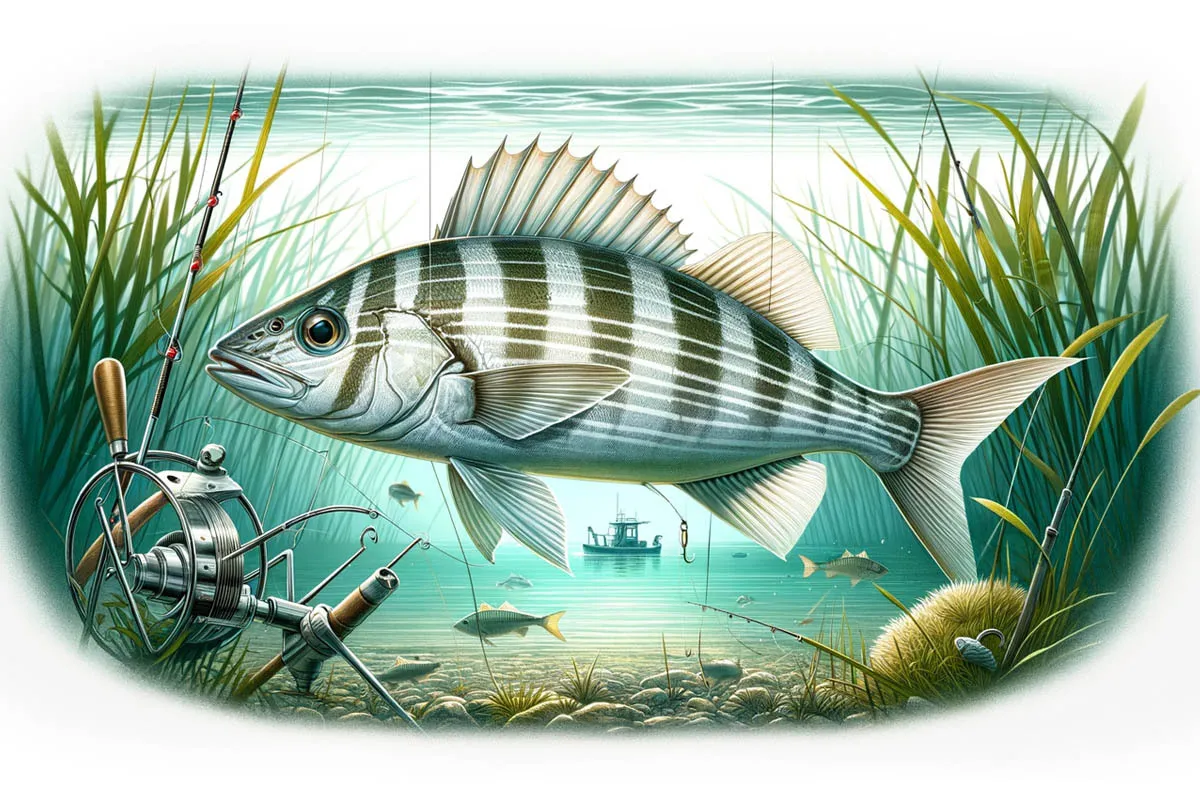
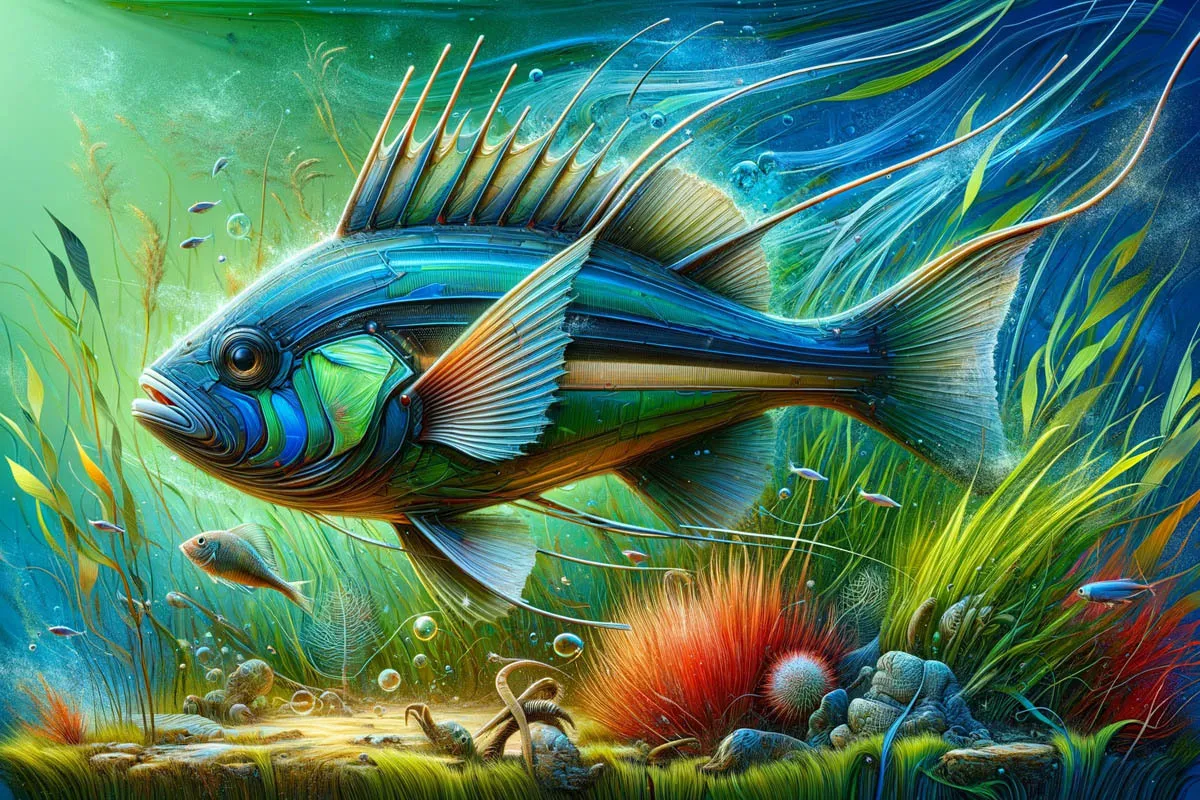
Where to Find Pinfish
- Pinfish habitat: Pinfish favor warm, shallow, and brackish environments, typically inhabiting estuaries, bays, lagoons, and nearshore reefs. They have a preference for staying close to the seabed, seeking shelter among vegetation, rocks, pilings, docks, and various other structures. Additionally, pinfish are often found near the peripheries of channels, drop-offs, and sandbars, which offer ideal spots for ambushing prey and evading predators.
- Best time of year to catch pinfish: Pinfish are catchable year-round, but they are notably more abundant and lively during the warmer months. Their numbers increase in spring and summer, coinciding with their spawning and feeding periods. Additionally, pinfish exhibit heightened activity during the morning and evening hours, which are their primary feeding times. In contrast, their abundance and activity diminish in the fall and winter, aligning with their migratory patterns and reduced feeding habits. Moreover, pinfish tend to be less active in the middle of the day, a period they typically use for resting.
How to Catch Pinfish
- Cast nets: Cast nets, which are circular in shape, are thrown over a school of pinfish and retrieved using a rope. They represent one of the quickest and most efficient methods to catch a large quantity of pinfish in a short duration. Additionally, cast nets are cost-effective and straightforward, as they don't necessitate bait or tackle. However, there are certain drawbacks to their use. Mastering the technique of accurately and effectively throwing a cast net requires significant skill and practice. There's also a considerable risk of harming or killing pinfish, as they may become entangled or crushed in the net. Furthermore, cast nets can inadvertently capture non-target or protected species, such as turtles or birds, potentially leading to legal or ethical complications.
- Sabiki rigs: Sabiki rigs, which consist of multiple hooks attached to a main line and a weight, are among the most favored and efficient methods for catching a reasonable number of pinfish within a moderate timeframe. These rigs are highly versatile and adaptable, suitable for various water depths and currents. However, there are some downsides to their use. Sabiki rigs often require significant amounts of bait and tackle for effective use. They also have a tendency to tangle or snag, leading to potential frustration and time loss. Additionally, there's a considerable risk of improperly hooking pinfish with Sabiki rigs, which can result in injury or death to the fish.
- Traps: Traps, which are baited containers submerged in water, serve as an effective means to attract and capture pinfish. They are considered one of the most convenient and humane methods for catching a substantial number of pinfish over an extended period. Additionally, traps are economical and environmentally friendly, as they typically do not necessitate the use of extra bait or tackle. However, using traps does come with certain limitations. Setting them up and routinely checking them demands considerable time and patience. There's also the possibility of a lower success rate in selectively catching pinfish, as traps may also attract and capture other species like crabs, catfish, or stingrays. Learn more about pinfish traps in this video: Best Live Bait for Redfish
- Hook and line: Using hook and line is a traditional and classic approach for catching a small quantity of pinfish quickly. This method is often seen as the most enjoyable and gratifying way to fish for pinfish, providing the angler with a direct experience of the fish's bite and struggle. However, there are some challenges associated with hook and line fishing. It requires considerable skill and experience to be effective. Additionally, there's a significant risk of harming or fatally injuring the pinfish, as they can be hooked in sensitive areas like the mouth, gills, or gut. There's also a notable chance of losing the pinfish during the process, either through them escaping off the hook or being taken by predators. Captain Williamm Toney covers catching pinfish with hook-and-line in this video Live Bait Tactics for Pressured Redfish
How to Rig Pinfish for Bait
- Free-line rig: A free-line rig offers a straightforward and natural setup for rigging a pinfish. This rig is composed of a hook, a leader, and a main line, and is designed to allow the pinfish to swim uninhibitedly and naturally, free from any weights or floats. This method is particularly effective in shallow and calm waters where there's minimal or no current, making it ideal for targeting surface-feeding fish like tarpon, mahi mahi, and cobia. To use a free-line rig, the pinfish should be hooked either through the nose or the back before casting it into the vicinity of the target area. It's important to allow the pinfish to swim freely, maintaining a slack line, until a bite is felt. Upon detecting a bite, swiftly and firmly set the hook and proceed to reel in your catch.
- Float rig: A float rig is a widely used and efficient method for rigging a pinfish. Comprising a hook, a leader, a float, and a main line, this setup allows the pinfish to maintain a specific depth and distance, preventing it from sinking or drifting away. The float rig is particularly suited for fishing in deeper and more dynamic waters with stronger currents, targeting mid-water column feeders like snook, seatrout, and jack crevalle. To utilize a float rig effectively, the pinfish should be hooked either through the nose or back, and a float attached to the leader. It's important to adjust the leader's length and the float's size according to the water's depth and current. Once cast near the target area, the pinfish swims beneath the float. Watch for any signs of movement or changes in the float's position, indicating a bite. Set the hook promptly upon noticing a bite, and reel in your catch, taking care to prevent the float from becoming tangled or snagged.
- Bottom rig: A bottom rig is a widely favored and dependable setup for rigging a pinfish. This rig includes a hook, a leader, a weight, and a main line. It is designed to allow the pinfish to swim close to the seabed, an area rich in cover and food. The bottom rig is particularly suitable for fishing in deeper and more rugged waters with significant structure, and it's effective for targeting bottom-feeding fish such as snook, redfish, and black drum. To use a bottom rig, the pinfish should be hooked either through the back or tail, and a weight attached to the leader. It’s crucial to adjust the weight and the length of the leader based on the water’s depth and current. After casting the rig near the desired area, allow the pinfish to swim close to the bottom. Pay close attention to your line for any signs of vibration or tension, indicating a bite. Once you detect a bite, set the hook promptly and reel in your catch, being careful to prevent the weight from getting snagged or buried.
- Drift rig: A drift rig offers a dynamic and engaging way to rig a pinfish. This setup includes a hook, a leader, a weight, a swivel, and a main line, allowing the pinfish to swim at varying depths and distances that change with the boat's speed and direction. Ideal for fishing in open and clear waters with minimal structure, the drift rig excels in targeting widespread and mobile fish such as cobia, mahi mahi, and mackerel. To effectively use a drift rig, hook the pinfish through the nose or back, and attach a weight and a swivel to your leader. It’s important to adjust the weight and leader length according to the water's depth and current. Cast the rig behind the boat and let the pinfish swim along with the drift. Remain vigilant for any line movement or changes, signaling a bite. Once you notice a bite, set the hook quickly and reel in your catch, taking care to prevent the weight from becoming tangled or snagged.
How to Fish Pinfish Effectively
- Choose your pinfish wisely: Selecting the right pinfish for your fishing endeavor is crucial and should be based on the size and species of the fish you're targeting, as well as the condition and availability of the pinfish. Opt for pinfish that are in good health, active, and fresh, as these qualities make them more appealing to other fish and ensure they last longer on the hook. Additionally, it's important to match the size of the pinfish to the type and size of your target fish to enhance your chances of a successful catch and minimize bait wastage. A useful guideline is to choose a pinfish approximately one-tenth the length of the fish you're aiming to catch. For instance, when targeting a 30-inch snook, a 3-inch pinfish would be an appropriate choice.
- Handle your pinfish carefully: It's important to treat pinfish with care and respect, recognizing that they are living beings capable of experiencing pain and stress. Oh No! Additionally, exercise caution and protect yourself, as pinfish possess sharp spines that can cause painful injuries to both you and your equipment. To minimize harm, avoid handling pinfish with bare hands; instead, use a wet towel or glove. When hooking them, be mindful not to injure or kill the fish. Employ a sharp, smooth hook for gentle piercing. Also, it's crucial to protect pinfish from exposure to air and sunlight. Always keep them wet and cool to maintain their well-being.
- Store your pinfish properly: It's essential to store your pinfish in a manner that maintains their quality, quantity, health, and well-being. Ensure they are kept in a well-aerated and insulated livewell or bucket, and make it a point to regularly change the water. Additionally, be cautious not to overcrowd or overfeed them, and consider separating them by size and species to prevent stress and competition. Aim to create a tranquil environment for the pinfish, avoiding any actions that might stress or agitate them, to keep them calm and content.
- Present your pinfish naturally: It's crucial to present your pinfish in a manner that closely resembles their natural movements and appearance, as well as aligning with their preferred environment and food sources. When hooking the pinfish, aim to optimize their ability to swim and survive, which in turn enhances your chances of a successful hook-up and improves the overall bait presentation. Additionally, rigging your pinfish should be tailored to fit the specific conditions of your fishing activity, including factors like the water's depth, current, and surrounding structures. Furthermore, when casting your pinfish, do so in a way that minimizes disturbance to the fish and accurately positions the pinfish in proximity to the intended target area.
- Retrieve your pinfish correctly: Retrieving your pinfish should be done in a manner that both attracts and stimulates the target fish, while effectively controlling and positioning your bait. It's important to tailor your retrieve speed and direction to suit the current mood and activity level of the fish, as well as taking into account the water conditions and the specific type of rig you're using. Additionally, vary your retrieve actions and patterns based on how the fish are reacting and responding, and also consider the type of bait being used and the species of fish you're targeting. Furthermore, carefully monitor the tension and slack in your retrieve, adjusting as necessary based on the fish's biting and fighting behavior, and the specifics of your hook and line.
The pinfish glimmers like treasure, but the real riches lie in its benefits as a baitfish.
SHPinfish Fishing Tips
- Match hook size to bait size for proper hookups
- Keep pinfish lively in aeration or recirculating livewells
- Use fluorocarbon leaders for low visibility to fish
- Quietly approach spots then cast baits out
- Expect light pickups - use circle hooks and reel on any feel of weight
- If pinfish dies, replace with a fresh lively bait
- Consider adding attractors like the Pro-Cure bait gel
Nutritional Value of Pinfish as Bait
Pinfish are a protein-rich bait, their flesh packed with natural oils and fats. This composition releases enticing scents into the water, making them irresistible to predatory fish. Moreover, their durable flesh withstands nibbles from smaller fish, ensuring longevity on your hook.
Seasonal Variations
Understanding the migration patterns of pinfish during colder months is crucial. Additionally, altering the bait used in traps to match their seasonal diet enhances your catch rates.
Local Knowledge
Every region has its unique methods for catching and using pinfish. Engage with local angling communities for those valuable insights.
Conclusion
Pinfish are an excellent choice for bait when targeting a range of game fish in the coastal waters of the United States. They are readily available, adaptable, and appealing to numerous fish species. However, to utilize pinfish effectively, a significant amount of knowledge and skill is required, along with careful handling and respectful treatment. It's essential to understand how to select, handle, and store your pinfish appropriately. Furthermore, it's important to be knowledgeable about the correct ways to present, retrieve, and strike when using pinfish. Additionally, adapting and adjusting your pinfish to suit the specific conditions and techniques of your fishing situation is crucial. By applying these tips and techniques, you can enhance your fishing experience and make the most of using pinfish as bait.
Seth Horne In The Spread, Chief CreatorUser Reviews



